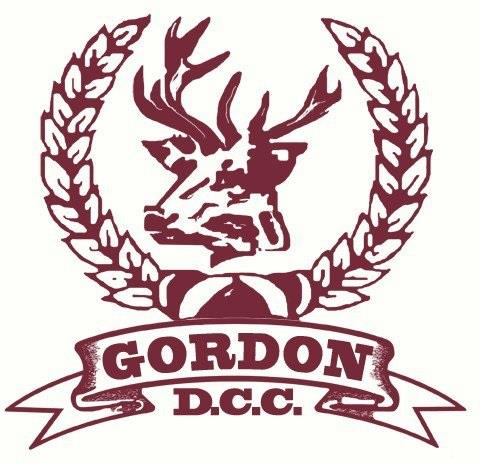Richard Stobo - thrived on the competitive battle
Gordon District Cricket Club | April 24, 2024
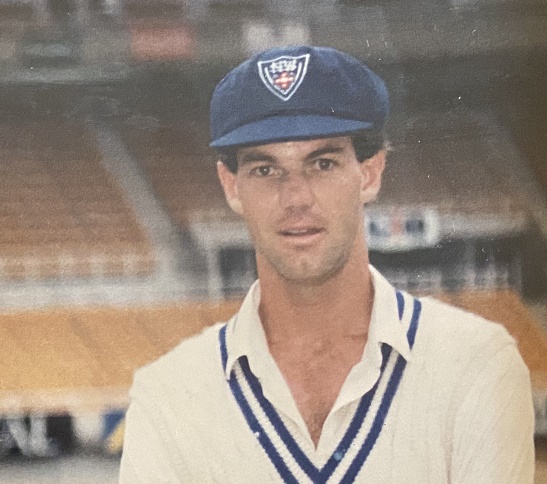
Richard Stobo made his first grade debut for Gordon Cricket Club during the 1983/84 season and went onto take 396 first grade wickets at an average of 21.18. His best figures was 7 for 20 and he took 5 wickets or more in an innings on an incredible 24 occasions.
Richard made his first class debut for NSW during the 1989/90 season and played 6 first class games and two one day games for the Baggy Blues.
A highly skilled and tireless fast bowler Richard thrived on the competitive battle and played in an incredibly strong era of cricket in NSW.
Let’s find out more about Richard’s journey.
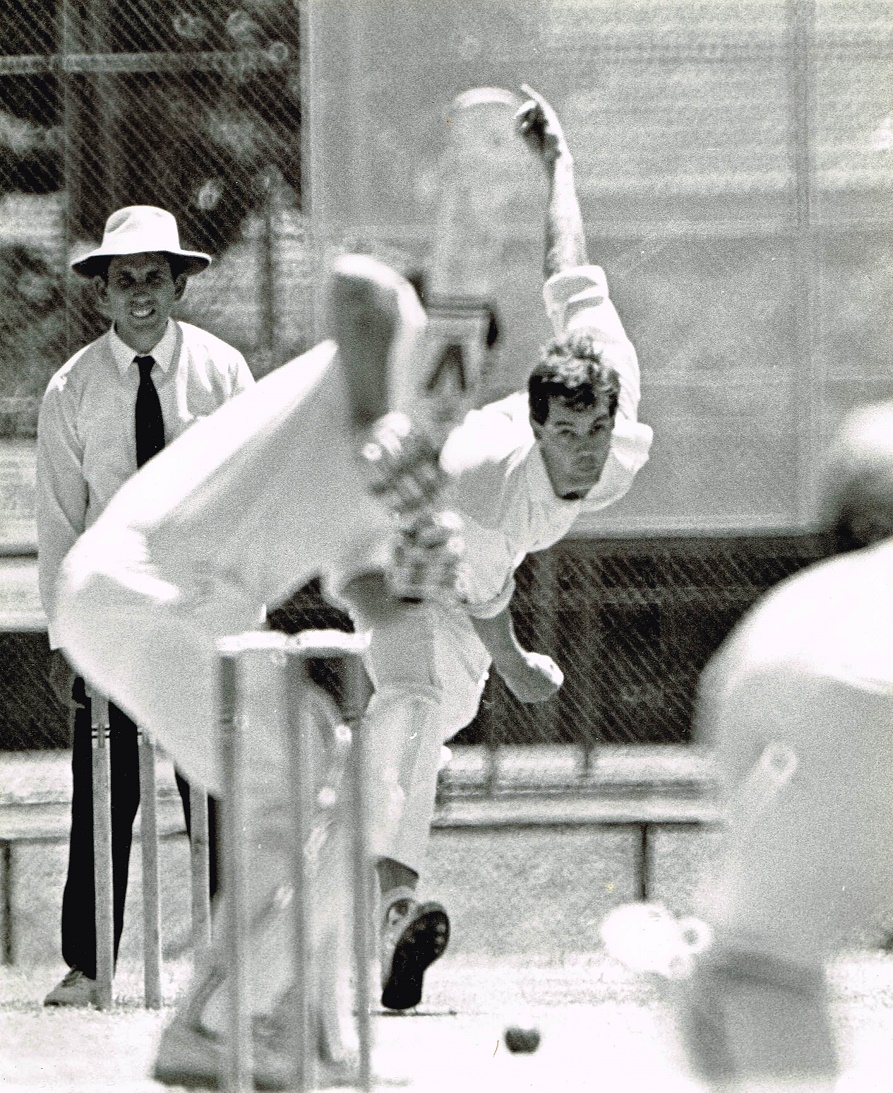
Richard Stobo bowling for Gordon in 1990
What year you were born?
1965 (in Toowoomba)
Can you remember you first game of cricket?
Knox U10As v Trinity. I took 5-20 and scored a golden duck. The coach was the great David Anderson, and he can vouch for it: we’ve been colleagues at the Shore senior school for the past 34 years.
Tell us briefly about your cricketing journey?
Like so many my age, I became hooked on cricket in the mid-1970s – the 1974-75 Ashes, the 1975-76 Windies tour, WSC, Lillee, Thommo, and all that. I was also very fortunate that Bob Thomas – a fine Gordon player and outstanding schoolboy coach – was teaching at Knox, and he set me on the path.
I played Green Shield for Gordon, played in the CAS team, and was picked in a NSW Schoolboys side in 1982 that included Steve and Mark Waugh, Justin Kenny, Gavin Robertson, Andrew Jones, Tony Dwyer, Dave Freedman, Brad McNamara, Andy Knight, Dave Moore – it was a pretty strong team. I played in the U19s in Melbourne the following season, but without much success.
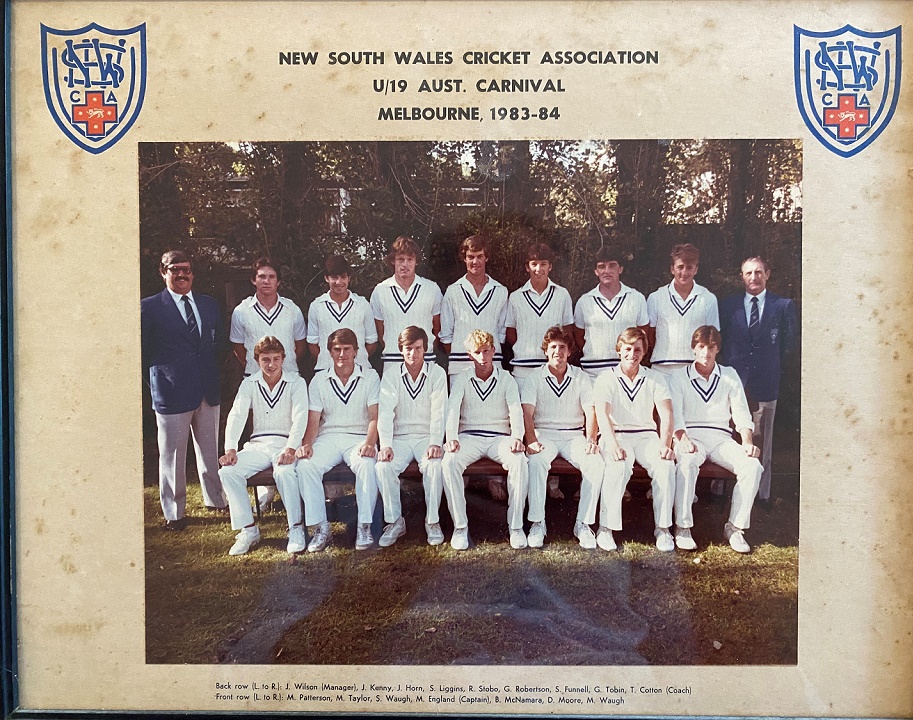
I played all my grade cricket with Gordon, from 1982 until the end of the 1993-94 season. We had some great years, including back-to-back premierships in 1989-90 and 1990-91. We made the semis for the next three years but couldn’t quite make another final.
I played a few Shield games in 1988-89 and 1989-90, but made myself unavailable for the next two seasons, partly because of work and family but also because I was frustrated by never knowing where I stood. I directed all my energy toward Gordon for the next couple of seasons and they were my best in grade, including a 64-wicket season and a couple around 50, I think.
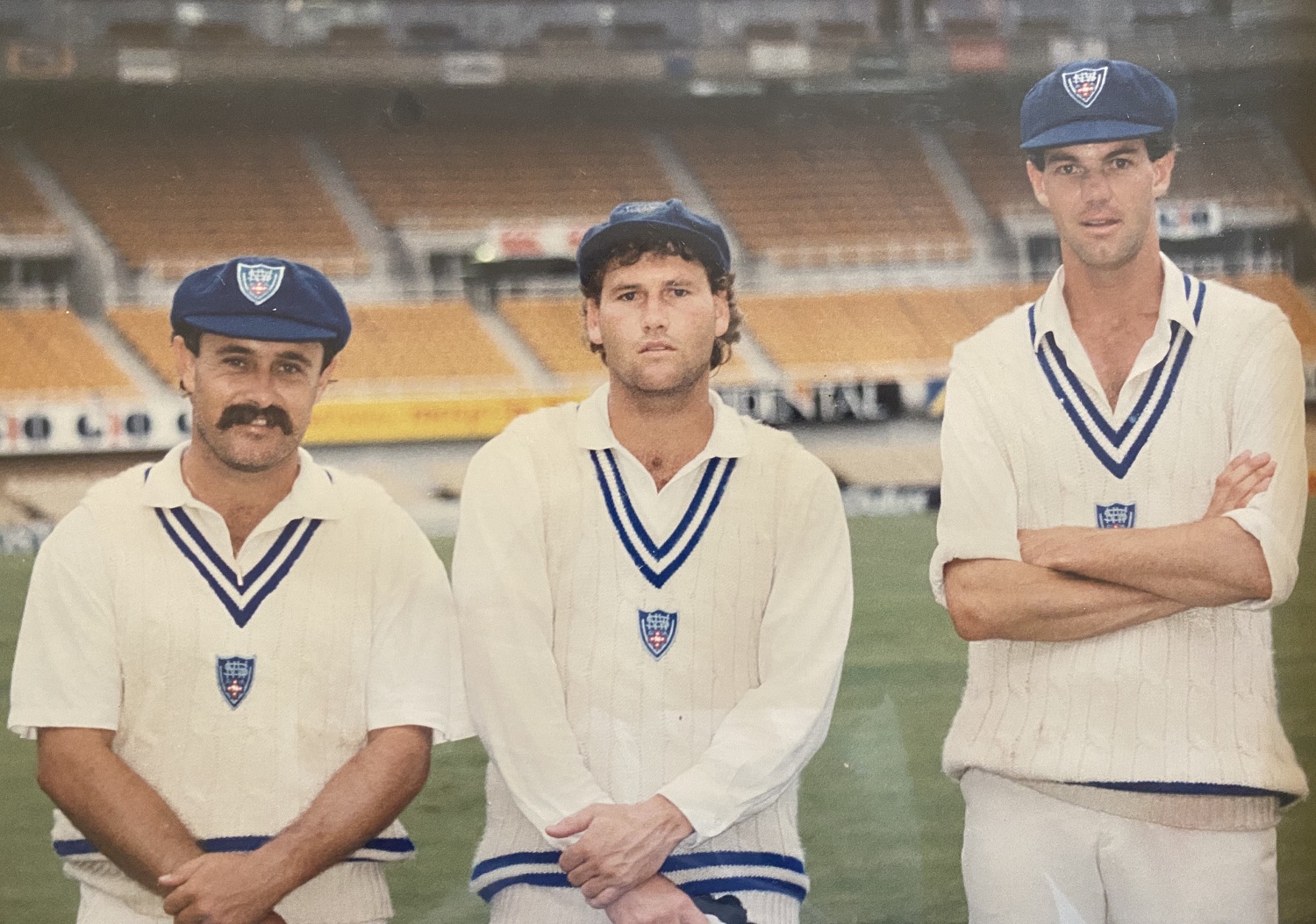
Gordon DCC Baggy Blues - Mark O'Neill, Phil Emery, Richard Stobo
I was asked if I’d be available for selection again in 1992-93, after Geoff Lawson retired. I thought why not, it looked like there might be a spot (I didn’t realise at the time that Glenn McGrath was about to hit the scene), did the pre-season work, took 7 for 40-odd against Penrith at Howell in Round 2, and was culled from the squad (along with a few others) the following Monday! In the end, weight of wickets probably told (and I reckon a 7-for at Bankstown carried extra weight), and I was chosen for a couple of 2nd XI games because a couple of the squad bowlers were out injured.
I remember taking 6-30 against Victoria in Melbourne, and was picked for the domestic one-day final (also against Victoria, but this time it was Jones, Lehmann, Fleming, Nobes, Elliott, etc.) the next week, and then the next Shield game, against Queensland at the Gabba. But when Mike Whitney passed a fitness test following that, I was out again.
I played one more season of grade and was still probably at the top of my game, but the enjoyment and hunger was waning, and I decided to pull the pin altogether before the 1994-95 season. I was only about 28 but had other interests, and cricket was never going to be my full-time career.
With Gordon struggling in the early 2000s, however, there was a move to get the club back on its feet and the best contribution I could make was to return and to play a couple of seasons in 4th Grade, with another former 1st Grader, Marty Reynolds. They were two of the most enjoyable seasons I had; we had a young team that lost the final narrowly the first year to Dave Stepto’s Mosman side, but we defeated Randy-Petes in the final the next. All of our games against Randy-Petes were really enjoyable, hard-fought contests, almost certainly because they also had a couple of good ex-1st Graders: Peter Devlin and Darren McCoy.
The following season, I opened the bowling in 2nd Grade and we just missed out on the semis. I was about 40 by then but still getting them through OK, and was actually selected to play a 1st Grade one-day game at Killara against Bankstown; unfortunately (or fortunately), the match was washed out.
In which grade and at what age did you make your debut in grade cricket?
5th Grade (captained by Richard Maude) against Sydney Uni at St Paul’s Oval in late 1982, after the HSC. I was 17. I was in 4th Grade the next week and played alongside Phil Emery for the first time. I remember we played Gav Robertson at Ryde Oval. Balmain also had Terry Regan, the Balmain league player, which added a bit of spice to the game.
I played the last half of that season in Warwick Murray’s 3rd Grade Premiership side – we defeated James Rodgers’ Sydney Uni team in a tense, low-scoring final at Waverley Oval. Good times. It was a great intro to Grade cricket.
At what age did you make your first-grade debut in grade cricket and can you remember how you performed in debut?
I played my first 1st Grade game under the late, great Phil Antman, against North Sydney at Chatswood early in 1983-84, aged 18. Phil was a magnificent man, very good seamer, and I learned an enormous amount from him. I remember bowling my first ball to Greg Bush, and taking 4 wickets; Michael Falk caught the first of them. It was a great time to be a young player; Shield and Test players regularly turned out for their clubs, I soaked it all up.
To give you some idea, Mike Whitney went out of his way in the middle of a Saturday/Sunday game at Coogee in about 1985 or 1986 to offer Andy Knight and me some thoughts about our bowling strategy. Fantastic. I guess he saw two young guys with a bit of promise trying hard and wanted to encourage us. Put simply, it says everything about Whit.
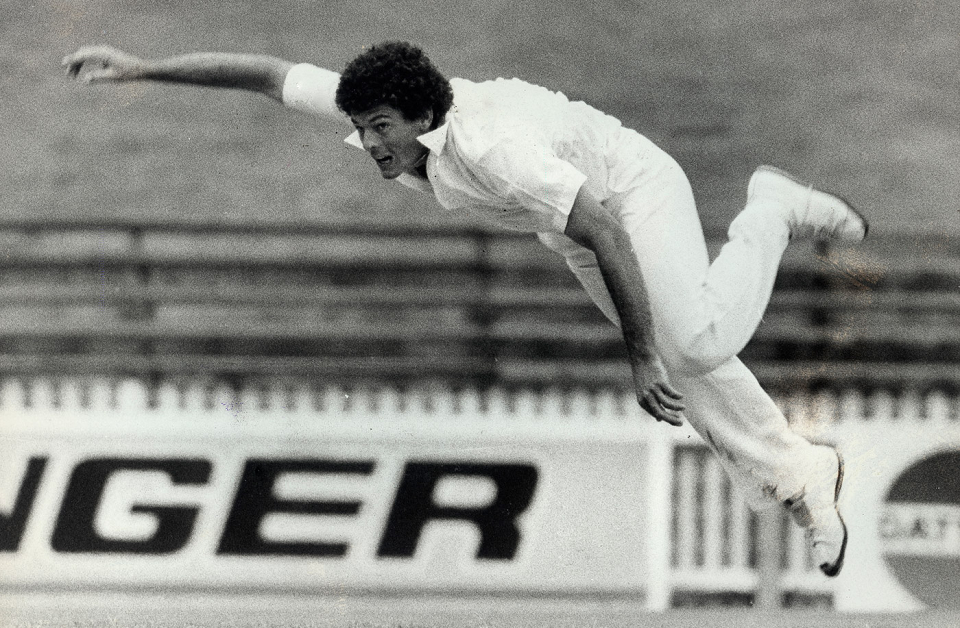
Mike Whitney
If you can share with our audience, how would you describe yourself as a cricketer?
Opening bowler, decent fielder, and genuine No. 11.
What were your strengths as a player?
A toss-up between my cover drive, square cut, and back-foot defence. Take your pick.
What was your highest score in senior cricket?
A nasty question. I’ll simply say that getting off the mark was my biggest problem among many. However, I did top-score in a game against Campbelltown on an ordinary wicket at Chatswood in the late 1980s. Their attack included Tommy Shiner and Winston Davis, the West Indian quick. Steve Day decided it would be good to hang around when he might have gloved one to the keeper off Davis. Winston wasn’t happy. He cleaned Steve up, and took it out on the rest of us. I don’t think we made 100 but I scored 23, which was more than anybody else!

Winston Davis
What were your best bowling figures in senior cricket?
I had quite a few 7-wicket hauls in 1st Grade but could never manage 8. I can’t recall my best figures exactly but I did get 10 of the 16 Balmain wickets that fell in the 1990-91 semi-final – that was my probably my best performance.
You played 6 first class games for NSW, can you share with us how you found out you’d been selected to play for NSW, who did you play and what do you remember about your first-class debut?
I’d just arrived at an end-of-year camp at Lake Macquarie at the end of my first year of teaching in 1988. One of the teachers had heard on the radio that Geoff Lawson was in the Test team to play the Windies in Perth (I bet he wished he hadn’t been because Curtley Ambrose broke his jaw in the first innings).
I’d been doing pretty well at the time and thought I must be close; a journalist called the camp to let me know I’d been selected. I raced back to Sydney the next day, got my gear, and drove back up to Newcastle to play a Western Australia team that included Kim Hughes, Tom Hogan, Terry Alderman, Alan Mullaly, Tim Zoehrer, Ken MacLeay, and Bruce Reid. Despite a Test being on, the NSW side included Greg Dyer, Mark Taylor, John Dyson, Mark Waugh, Steve Smith (the original version), Mike Whitney, Greg Matthews, and Peter Taylor. Gav Robertson was 12th man.
I thought I bowled OK in the first innings on a pretty dead pitch and had some close shouts but couldn’t jag a wicket. I picked up 1-16 off 10 in the second.
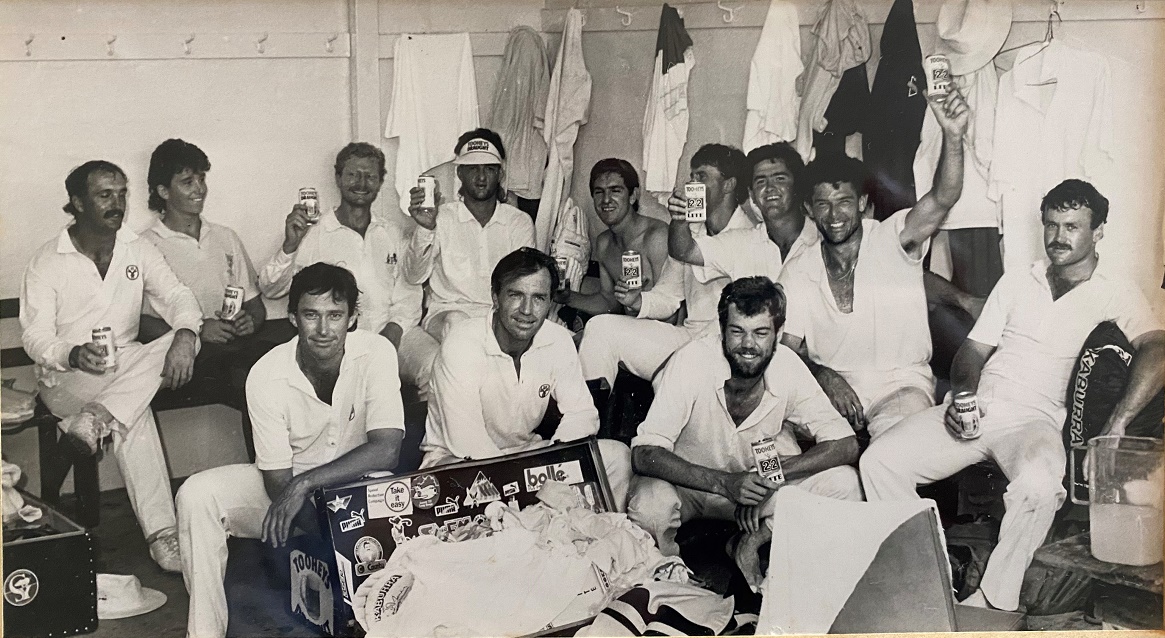
NSW Dressing room December 1988
You played at a time when NSW fast bowling ranks consisted of Lawson, Whitney, Gilbert, Holdsworth, Jones, Rowell, Alley, McGrath, not to mention the spinners, Matthews, Bennett, Taylor, Robertson, Freedman, what did it mean to you to be picked for NSW and how do you look back on your time in first class cricket?
I suppose playing in that era was both blessing and a curse. NSW was really strong, and it was very difficult to break into an established team, let alone stay there. Lawson, Whitney, and Matthews constantly reminded everyone that we were playing for the best state, province or county in the world. And they were right: NSW could easily have fielded two first class sides at that time. It also meant you played with some of the greatest Australian players ever to play the game.
I did well in 2nd XI games and picked up a couple of 6-wicket hauls but could never get two games in a row in the State side. There was so much competition at that time, I needed a haul early on to cement a place. And the SCG was a real spinners’ wicket in those days, and I didn’t possess all of the skills you needed to get good batsmen out on it.
Perhaps I might have received more chances a few years later when NSW was rebuilding. On the other hand, to play any game for NSW was a great honour, particularly at that time.
So, I only played a handful of Shield matches and one 50-over domestic game (which happened to be the 1992-93 final against Victoria), as well as one against Sri Lanka, but ended up with two Shield medals and a domestic one-day title!
Who were the best three fast bowlers you have played against?
Far too many to narrow down in Sydney grade cricket alone: ie. Whitney, Evan Gordon, Chardon, Gilbert, Radcliffe, Lawson, Bernard, Done, Milligan, Killen, B Lee, S Lee, Adlam, Alley, Ronny Davis, Wayne Daniel, and, arguably the best of the lot … Winston Davis. I know I’ve missed more good quicks, and I apologise.
I don’t really remember playing Glenn McGrath in grade, although I must have done a few of times. I played a couple of matches with him for NSW when he was just starting out, however, and he’s the benchmark.
I will make special mention of Andrew Jones, Wayne Holdsworth, and Greg Rowell, however. I played with and against all of them, we hit our peaks at about the same time, and basically competed for the third spot in the Shield team behind Lawson and Whitney. They were very different bowlers to each other but each led their team’s attack brilliantly and could run through an opposition line-up in a heartbeat. Jonesy, Greg and I each took 60+ wickets in 1990-91; I’m sure Cracker would have done likewise but he spent the season in the Shield side. I’ve always maintained the true test of a quick is his third spell of the day, not his first (anyone can look pretty dangerous with a new ball against new batsmen at 11 AM), and those three were all still a serious bowler in the last hour of play
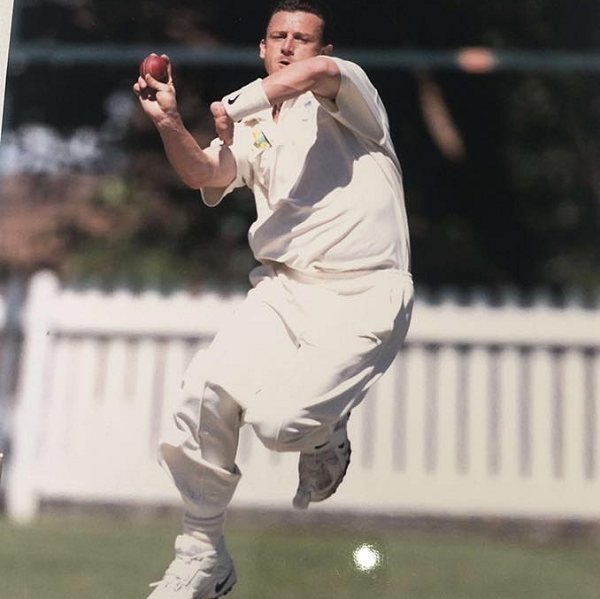
Wayne Holdsworth
Who were the best three or four spinners you have played against?
I’m not good at this sort of stuff – they all seemed pretty good to me. Steve Whitfield/Peter Taylor (I’ll treat them as one because they always bowled in tandem and were an outstanding combination), Murray Bennett, Tom Shiner. Gordon also had two excellent spinners in Mark O’Neill and John Davison – I loved bowling in partnership with both of them.
Who were the best 3 batsman you’ve played against?
Far too many to choose from. In my early days, I remember not having a clue how to bowl to blokes like Ian Davis, Steve Waugh, Mark Waugh, Rod Bower, Dirk Welham, Paul Bourke, Phil Marks, Graham Hughes, Greg Geise, Peter Toohey, Mark O’Neill (playing for Manly at that time), ... I always thought Les Johns was terrific because he was so experienced, and would take the game right up to you from the first ball.
I played a lot against Mark Taylor from Green Shield days and we had good battles for quite a few years, but that all changed when he returned from the Ashes tour in 1989 – he was then in a different league altogether.

Mark Taylor
I also played a few games against Graham Hick in the Birmingham League in England in 1985, and he was as good as anyone at that time. Otherwise, in Shield cricket: Law, Hilditch, Lehmann, Hayden, Hookes, Geoff Marsh, Veletta, Elliott, etc. … in fact, all of them.
Who played the best innings you’ve seen firsthand playing with or against?
I’ve seen so many great innings … Steve Waugh smashed a century against Gordon at Bankstown in early 1984, just after we’d returned from the U19s. He murdered us to all parts of the suburb, and beyond. That was a long day. Rod Bower then came in and hit me back over my head into the canal because, apparently, I’d “sledged his mate, Crowie”. Fair enough. Graham Smith belted us all over Hurstville on another long day, with balls peppering front gardens three streets away.
It was a privilege to witness Mark O’Neill’s 200 not out against Fairfield at Chatswood (in a club record partnership with Phil Emery of 326*). Wayne Seabrook and Sparky each scored about 150 in another game at Hurstville; outstanding innings from two unique individuals. And Gilly’s 60-odd in the final against Mosman against an excellent attack and under enormous pressure gave us a total to bowl at. He was only about 18 and it was mature beyond his years.
I’ll also mention an innings by Scotty Jacobson for the NSW 2nd XI against the ACT at Manuka in about 1989. Ken Macleod, the West Indian left-armer, bowled one of the scariest spells I’ve ever seen; all he wanted to do, it seemed, was kill someone. Scott scored a century in the first innings, when Macleod was at his nastiest. I think Macleod broke Scott’s hand along the way but he batted on – it was a really gusty knock. My memory’s a bit sketchy but I’m pretty sure a young Michael Slater scored a century in the second dig. Gordon Greenidge also played in that match for the ACT.

Steve Waugh
Were there any batsmen in particular who for whatever reason always you to cause you a few problems?
Lots, but I’d have to say Steve Waugh and Michael Bevan ahead of the rest. Steve’s the best cricketer I ever played with or against, while Bevo could hit the same delivery to any one of ten places on the field, and always along the ground. You could never tie him down and couldn’t get him out, which makes things tricky.
I also struggled against Geoff Milliken, who played the ball late and never played shots he didn’t have to: the ideal opener. Paul Bourke was similar, and Canty was our version. Wayne Seabrook had all the shots and if you didn’t get him early, he could destroy you. Randall Green, likewise.
Can you recall a time when you thought, wow, this is a step or two up from what you were used to in grade cricket?
The week after Mark Waugh played his first Test in Adelaide in the early 1990s, Gordon played Bankstown in a grade game at Killara. There was no Test or Shield game on, so the Bankstown team included both Waughs, Steve Small, Wayne Holdsworth, David Freedman, Terry Davies, Kenny Hall and Darren Mitchell, while we had Emery, O’Neill, Gilchrist, Adlam, Davison, and Roberts, Cant, Day. There were more than a dozen players who played (or would play) Shield cricket for NSW, including three of Australia’s greatest Test players.
And there was no question that everyone would turn out for their club – that was never in doubt. Perhaps it might happen today, but I’m not so sure. I suspect some physio or coach would forbid it, or limit how many steps they could take on the day. It was a seriously tough day of cricket, with plenty of words said, and no one backed off. The next day, players from both sides flew out together for a Shield match. (I think they put Sparky next to Jack on the plane – wish I’d been in the row behind). Bankstown led on the first innings, but we ended up winning outright because half their team had left for the Shield game.
Who was the best wicket keeper you’ve seen firsthand playing with or against?
There were a lot of very good keepers in Sydney over the years: Steve Rixon, Les Andrews, Greg Dyer, Mark Atkinson, Paul Ryan, Andrew Millican, etc., but Phil Emery was the best I was lucky enough to play with or against. I’ve known Phil since schooldays, and we first played rugby against each other in 1982. We came through the ranks together at Gordon and shared a lot of great times, on and off the field. He was the complete keeper: brilliant to all bowlers on all grounds, in all conditions, and his record for NSW is unsurpassed. He was unlucky not to play more Tests.
Phil also knew my game inside out – probably better than me – and I reckon we formed a pretty good team. His leg-side catch late on the second afternoon of the final against Mosman to dismiss Scott Atkinson off Warwick Adlam was sensational and went a long way making us believe we could win that match. His catch to dismiss Gary Bensley off O’Neill in the same game wasn’t far behind.

Phil Emery
Who are the players you admired most in terms of skills and competitive spirit in the competitions you played?
Steve Waugh, Geoff Lawson, Mike Whitney. Of my Gordon teammates: Michael Cant.
Who was the best captain you had the good fortune to play with?
Steve Day. Hands down. If Brearley has a degree in people, Steve has a Masters. Liked and highly respected by everyone, tactically excellent, and always knew how to deal with and get the best from every player. We had a talented side in the late 1980s but it was a pretty remarkable mix of characters, with youngsters (Adlam, Gilchrist, Davison, Roberts, Maclean) and the older crew (Emery, O’Neill, Day, Aldridge, Liggins, Danckert, etc.). All the ingredients were there and but I reckon we needed Steve’s leadership to turn us into serious contenders, and then a Premiership team.
His outfield catch at a crucial moment in that Balmain semi-final – running away from the wicket looking over his shoulder and diving to catching it over his head (he split his webbing in the process) – was one of the best I’ve ever seen on a cricket field.
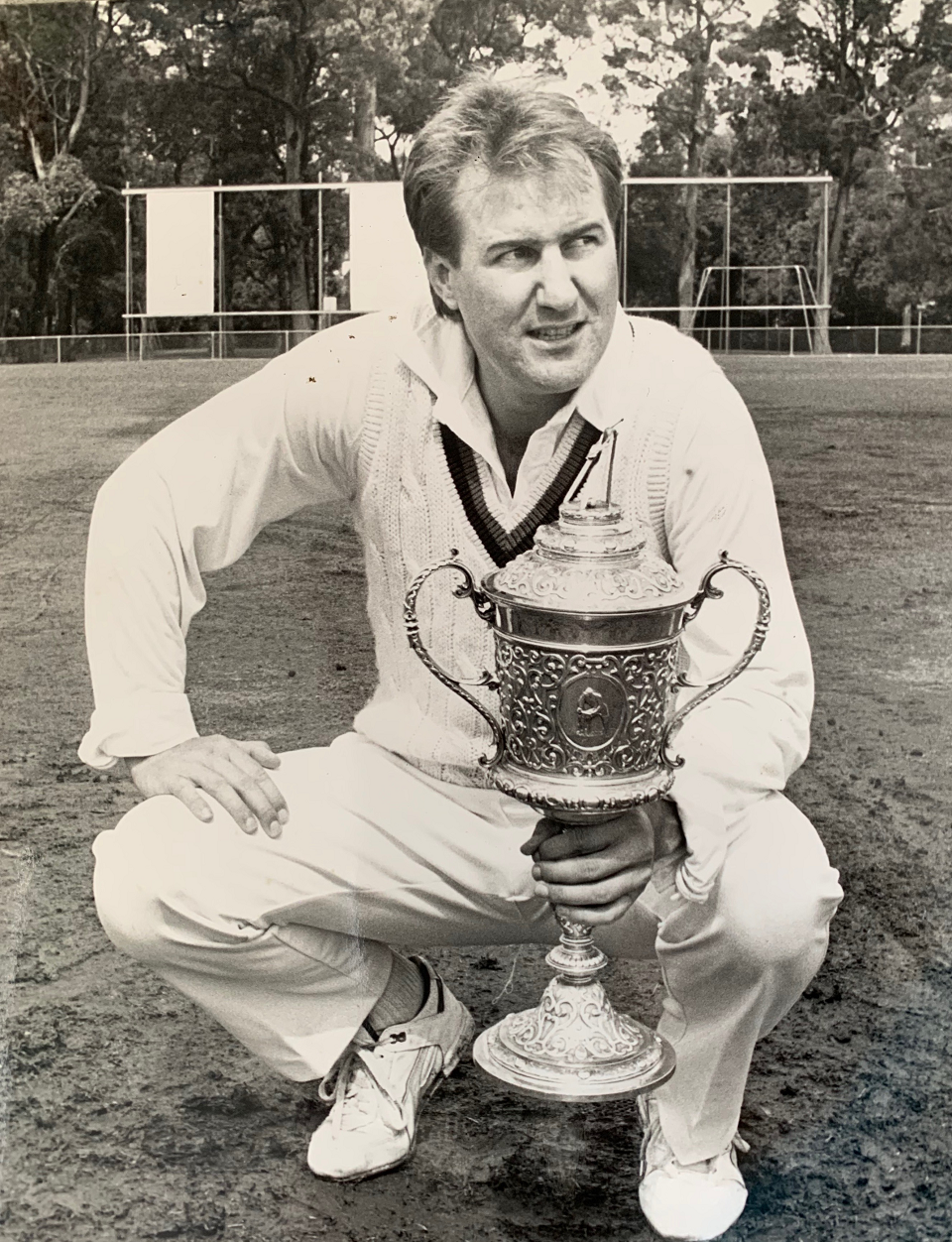
Steve Day
Who has been your funniest teammate?
Mark O’Neill. Sparky is a unique individual who sees the world through a lens no-one else uses. To have him and Steve Liggins in the one changing room made no sense and shows what a broad church cricket is: every other human who’s ever lived is on the continuum in between.
Second place: Craig Macgregor.
Can you recall some banter or an exchange on the cricket field that still makes you laugh today?
We were playing Randwick at Coogee. Our opening bowler, Mark Aldridge (‘Needle’) was bowling to the great Richard Chee-Quee. Needle had a short run but could bowl a really nasty short ball, and he did clean-up one or two blokes over the years. On this day, he sent one whistling past Cheek’s helmet. Needle followed through and had a word to Cheeks – I was at fine-leg and couldn’t hear it (I could never really understand what Needle was talking about at the best of times) but I got the gist that he didn’t rate Cheeks. I’m pretty sure that’s how Cheeks heard it as well.
What he did next was magnificent. He spun round to the stand and called for his white floppy hat. We had to wait while someone ran it out, and then ran Cheek’s helmet off. Needle was steaming by this time, and charged in to bowl another bouncer – of course – which Cheeks smashed out of the ground near the pavilion. Brilliant.
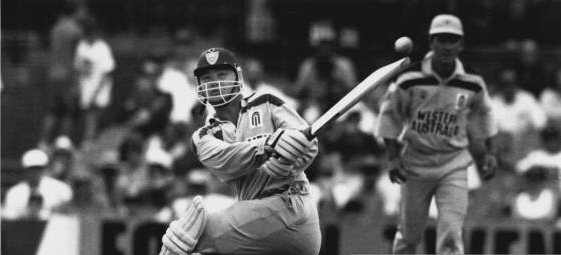
Richard Chee Quee
What was your most embarrassing dismissal in senior cricket?
They were all embarrassing at different levels.
Who was your childhood heroes?
Dennis Lillee, Graham Langlands
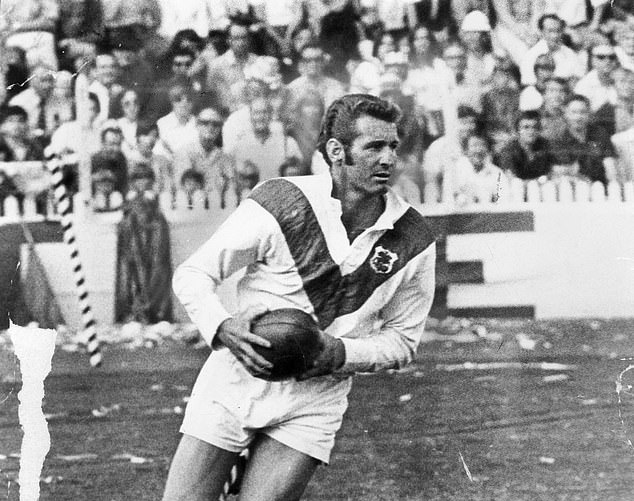
Graeme Langlands
Who are the three sports people in the world you’d most like to meet?
You never want to meet your heroes; you’re sure to be disappointed.
Who is your favourite cricket commentators?
Kerry O’Keefe.
What was your favourite ground to play at?
I have fond memories of Bert Oldfield Oval in Killara. I grew up only 100 yards away (Bert Oldfield lived at the top of our street), and it holds a lot of great memories, including our first premiership.
Elsewhere, I always enjoyed bowling at Chatswood, Caringbah, Drummoyne, Manuka, and the Albert Ground in Melbourne. I was lucky to play a number of times at the SCG, of course, (I first played rugby there in a curtain-raiser in 1982), as well as the other Australian Test grounds, New Road (Worcester), and Edgbaston … all wonderful places.
What there a particular team you especially looked forward to playing against?
I always enjoyed playing Northern Districts. Gordon and NDs were pretty evenly over the years and we all knew each other well, partly because a number of very good players had made the move from Waitara to Chatswood, or vice versa. We received players like Day, Cant, Liggins, while they received Adam Gilchrist, among others. We played each other in three really good semi-finals, two of which were draws, I think, and they progressed to the final.
They were led brilliantly by Ross Turner – I would have been very happy to play in any of his teams – and how can you not like playing blokes like Jack Moran, Neil Howlett Chris Elder, Mark Taylor, Randall Green, Peter Taylor, Michael Coote, Tim Ebbeck, Peter Vilimaa, etc.?
A great and proud club, which I always respected.
What are your most memorable moments in cricket?
Toss up. Winning the premierships; taking four wickets in five balls (including a hat trick) against Sutherland; cover driving Geoff Lawson for four in the initial City of Origin v Country of Origin match at the SCG in 1988 – Whit and I scrambled through for a single to win the match 9 down off the last ball. And fielding in the slips at the Gabba for a few overs with McGrath bowling: Emery keeping, Matthews at first, Gilchrist at second, Stobo at third. I wish someone had taken a photo.
What’s the best win you’ve been involved with?
The semi-final win by a handful of runs against Balmain at Drummoyne will always stand out – a simply magnificent match between two very strong and evenly-matched teams – closely followed by the following week’s final win against Mosman. Sensational, nail-biting games of cricket, in which every minute counted. It was a memorable fortnight.

Gordon District Cricket Club Premiers 1990-91
Who are the players from your playing days at the top of the list for a Saturday afternoon barbeque?
Steve Day, Phil Emery, Michael Falk, Michael Cant, Geoff Hickman.
Your son Charlie is also a fast bowler and to date has played 3 first class games. What was it like to watch him follow in your footsteps and did you share any advice with him before he made his debut?
I’ve been really pleased for Charlie – he’s a good kid who works hard, and he’s a much better player than I was. He can bat, for a start. He won the O’Reilly Medal in his second season but, as I’d also discovered, NSW can be a hard nut to crack. He’s picked up 13 wickets in three Shield games at about 23 (including 7 on debut, against SA), which isn’t shabby, but it was pretty obvious that there weren’t going to be many opportunities for him here, so he made the decision last year to move to WA.
It’s been a great thing for a host of reasons, and he’s doing well, both on and off the field. He loves Perth, and the people there have been fantastic and encouraging, and he quickly felt at home. He did well enough last season to be picked for a one-day game against SA, and hopefully there’ll be more opportunities down the track – but he’ll have to earn them. He’s putting in the work and loves the environment.
He’s training with the state squad and has been named captain of the University club for the season ahead, which is a real honour. He’s also in the final stages of his Arts/Law degree, so he’s also in a pretty good place re. Life outside cricket.
As for advice, three things: 1. Good length, top of off. 2. Good length, top of off. 3. Be the bowler the captain wants to throw the ball to when the going’s tough.
Incidentally, it occurred to me that I once dismissed Darren Lehmann in a Shield game at the SCG, and Charlie dismissed Jake Lehmann in a Shield game at the SCG. Not sure if a father and son had ever dismissed a father and son in first class cricket (and on the same ground) but if it has, it can’t have been very often. Just a thought.
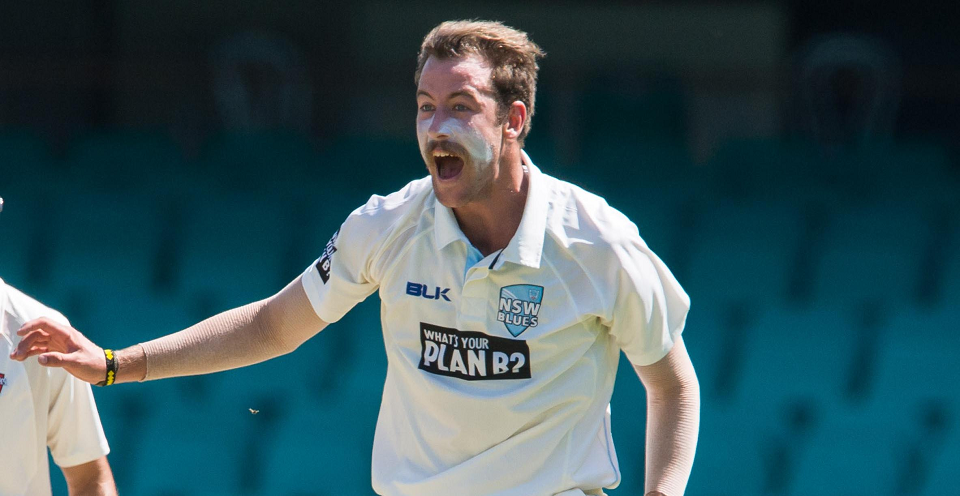
Charlie Stobo
What are your hobbies?
Golf and history. I started playing golf seriously about eight years ago; I’d play every day if I could but I have to tidy up bits of my short game. And I’ve always had a real passion for history. I recently completed a PhD in military history through UNSW (Canberra) (ie. ADFA), and would happily spend the rest of my days researching and writing. And playing golf. In fact, some day I think I will.
What’s the best advice you’ve received?
Make sure your putts always gets to the hole because the hole will never come to you.
What is your occupation?
I’ve taught History at Shore (as well as doing a few other things) since 1988. It’s the only place I’ve worked; I was very lucky to be given the opportunity straight out of Uni and have never looked back.
Are you still involved in cricket and if so, in what capacity?
I’ve coached at Shore (Phil Emery’s old school) for the past 34 years but I’m beginning to wind that down. I ran the school’s programme for a decade or so, and was also Convenor of GPS Cricket for a number of years. Shore has a long, proud history and we’ve had a lot of success over the years and I’ve seen some fine players go through, including a few who’ve gone on to play first-class cricket (Jon Moss, James Packman, and Charlie), and many more that have played 1st Grade.
If you were running a state cricket association what would your 2 priorities to ensure cricket in the state remained strong and successful on and off the field?
This is fairly brief but trust me, there’s a lot more I could say!
The world’s changed so much and so fast in recent times the game I know and love is now part of another age, I’m afraid, so I’m probably not the best person to suggest ways to keep it strong.
However, looking at my little pocket of the world – the large private schools – the game’s withering on the vine. Boys are heading to basketball in droves because it’s less time-consuming and doesn’t require the same patience or intricate skill set. From what I’ve seen, however, T20 is not the answer at junior level, unless we want to do away with the more traditional forms altogether and make T20 the only game to play. Not sure that would work.
Cricket’s a nett exporter of players and coaches – many more move away than decide to take it up. Shore had 24-25 teams a decade ago; we now have about 16, and I imagine that number will only continue to drop over time. I forget exactly how many of our 1200 boys play basketball, but I’m pretty sure it’s well over 600 … and we’re better off in terms of cricketers than many other big schools.
There are still very good players around, of course, but it’s difficult to find coaches – good or otherwise – for a variety of reasons. Cricket’s being held together in several large schools by one or two outstanding individuals, therefore, but they’ll retire in due course and there’s likely to be no-one of the same calibre to take their place.
I’d love to see Cricket NSW take an interest in the independent schools before it’s too late; it’s been such a long-held frustration (not only for me but also several other experienced teachers/coaches that I know and respect) that I’ve pretty much given up on it and moved on. I’ve never understood why such an obvious concentration of players is ignored. The Schoolboys Association has been disbanded. Most of the boys at Shore don’t play club cricket and therefore never make it onto the Cricket NSW radar. And because the focus is so clearly on elite squads and rep teams, those boys simply drift away from the game as soon as they finish at school. We must water the roots more effectively.
Ironically, as Michael Carr-Gregg, the prominent psychologist, has argued, cricket is the ideal sport for boys because it does take time and keeps them occupied, is excellent for developing social skills because you spend so much time off the field, and can allows for healthy interactions between players of different ages. We must somehow get that message across to parents.
Finally, a couple of thoughts re. The wretched ‘pathway’ (perhaps ‘conveyor belt’ is more apt – once you’re on, the ride seems pretty cruisy and takes you along way down the track, but if you don’t get on early, you’re likely to fall off very easily!):
- Please understand that talent identification and development at a young age is notoriously flawed. Boys mature (physically and psychologically) at different ages, and that can make a mockery of talent ID before the age of about 18. I’m strongly against boys specialising in a sport from a young age – it’s unhealthy and frequently counter-productive. It often means that far too much time and effort is spent developing young players who won’t stay the course and go on to play any senior cricket for any length of time, if at all. In Jack Gibson’s words, ‘potential never won anything.’ Consistent performance and experience against men – not boys – should always carry more weight in selection than youth and ‘potential’.
- And speaking of selections, I wonder if a panel of astute and experienced judges, which gets around to grade grounds every Saturday and then meets to discuss players and their performances before then selecting teams might be a good thing? Just a thought.








